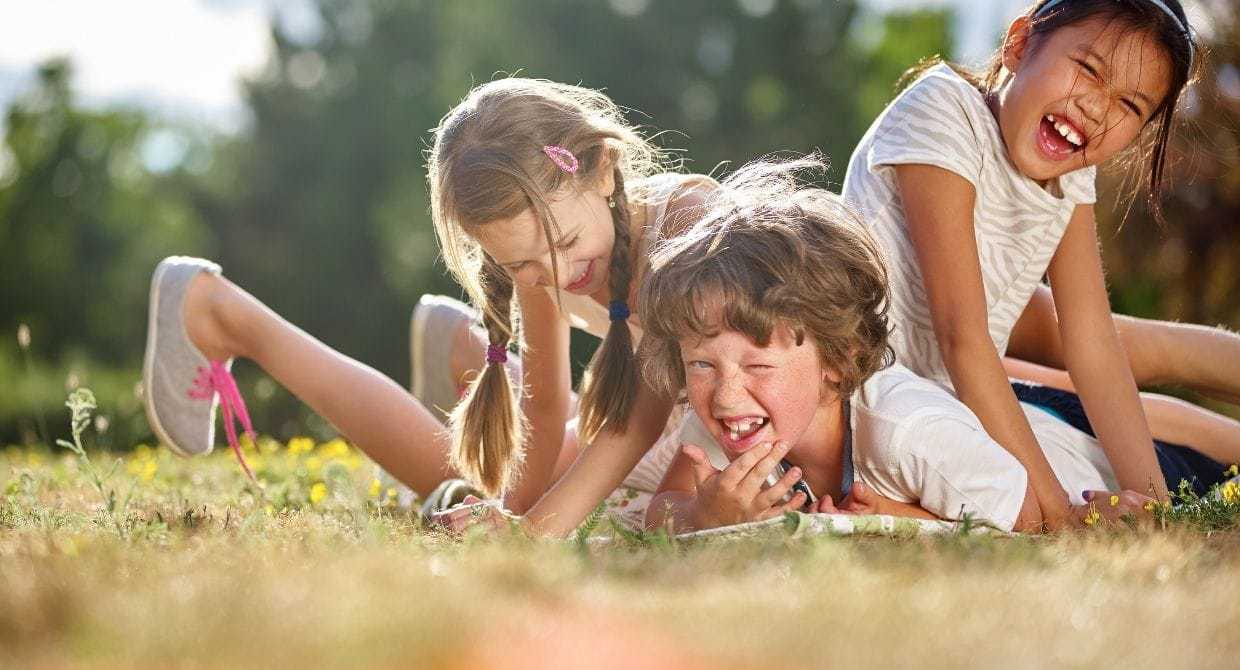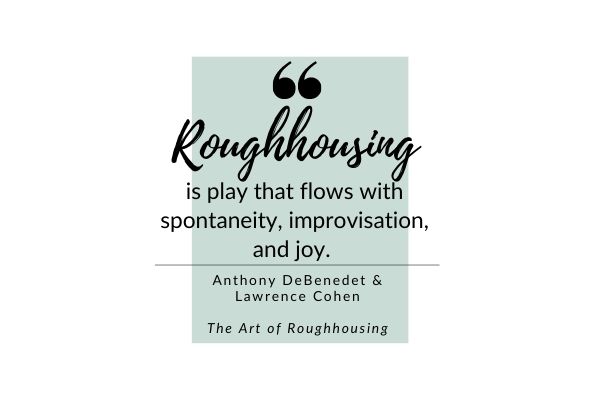The Playful Parent’s Guide to Roughhousing

Crash!
You wince as the sound of glass smashing onto the hardwood floor echoes from the living room. Quickly, you run into the room, pretty sure you know what scene you’re about to come across.
Just as you suspected, there lies your favorite crystal vase, shattered to pieces amidst a sea of wilting flowers. Your children stare at you from their spot on the ground, arms entangled, waiting for your reaction.
You open your mouth but don’t know what to say. A million things come to mind…
Look at what you did!
How many times have I told you not to roughhouse?
Why don’t you ever listen?
You need to play nicely!
Instead, you hold back and take a deep breath. Sure, controlling your temper is proving to be rather challenging–after all, you must have asked them not to roughhouse at least fifty times (this week!). But as the saying goes, this isn’t your first rodeo. And if there’s one thing you’ve learned time and time again, it’s this: yelling won’t help.
But what can you do?
First off, friend, let me assure you, I know exactly how you feel.
You’ve given everything you have to be the best parent you can be. You’ve taken the classes, read the parenting books, and listened to all the experts.
Yet, when you find your children roughhousing (again), you feel a little hopeless. Isn’t there something you can do to make it stop?
But let’s pause for a moment.
Now, I know from the outside looking in, roughhousing appears, well–ROUGH! It seems so brutal and violent. Not to mention heart-stopping (I mean, really. Do they want to go to the hospital?). We can’t possibly let our children act that way…right?
Believe it or not, the answer is yes. We can let them act that way!
Because the truth is, roughhousing–when done right–is NOT a bad thing. It actually has some fantastic benefits!
Let me explain…
The Science of Roughhousing
Roughhousing–or as some call it, “Rough and Tumble Play”–looks a bit sketchy on the outside (especially to us moms–yikes!). But science tells us there are numerous benefits to this type of play.
In fact, in their book The Art of Roughhousing: Good Old-Fashioned Horseplay and Why Every Kid Needs It, Drs. Anthony DeBenedet and Lawrence Cohen suggest that roughhousing has both intellectual AND connective benefits.
You see, when our kids are roughhousing, their brains release a chemical known as a brain-derived neurotrophic factor (BDNF). You can think of this as a type of fertilizer that stimulates brain growth.
How neat is that?!
Each time they start horsing around playfully, their brains are treated to a healthy boost of stimulation that will not only lead to stronger intellectual and social development but will help them learn to regulate their emotional responses as well.
This type of rough play between kids or with parents is also an excellent way to build connections with others. When done the right way–with both parties having a good time playing–the brain releases a significant dose of oxytocin.
You know oxytocin–the hormone that gives you all those warm, loving feelings? It’s the same thing that’s released when we share a hug or snuggle our kiddos.
Seeing your kids playing so wildly may give your heart quite the fright, and the thought of joining in? Forget about it! But you can rest assured knowing there are a lot of benefits resting just below the surface.
Here’s the thing…it’s not your job to stop the rough and tumble play. But it is your job to teach your children to partake in the right way.
Follow these tips to make sure your kids’ roughhousing stays playful, fun, and harmless!
Tips for Roughhousing the Right Way
Tip #1: Know the Difference Between Play Fighting and Real Fighting
You’re standing at the kitchen sink, multitasking as usual. As your hands wash the dishes, your eyes keep darting out the window, checking on your kids playing in the backyard.
Your oldest is jumping on the trampoline with his little brother, and the two are getting along well. You look down to grab another dish only to glance up a few seconds later to find things have changed…drastically.
Suddenly, the two boys are no longer happily bouncing up and down. Instead, they’re rolling across the trampoline, arms entangled, legs thrashing. Your oldest puts his brother in a headlock and messes up his hair, but the little guy soon wiggles free and jumps on his brother’s back.
Naturally panicked, you run outside to put a stop to the fighting. However, upon closer inspection, you notice things look a little different. Are the boys actually…laughing?
From afar, it’s easy to understand how play fighting can be mistaken for real fighting. After all, it’s still technically fighting.
But there are key differences between the two. And when you learn to recognize the signs, it’s much easier to accept roughhousing for what it is–another form of play!
When kids are play fighting, “attacks” are simulated and “held back.” By that, I simply mean they’re pretend. It looked like your oldest had his brother in a severe headlock, but up close, his grip was actually loose enough to let him easily slip out.
When fighting for play, punches are softened, tackles are less aggressive, and attitudes are usually pretty cheerful. And afterward, there are no hard feelings.
When kids fight for real, however, all the rules go out the window.
Happy shrieks are traded for angry cries. The intention of fun is replaced with a desire to harm. And when the fight is over, anger remains.
As a parent, you know your children better than anyone. And I’d be willing to bet you have a pretty good understanding of when they’re fighting for play versus when they’ve entered a full-on knock-down-drag-out match.
So keep an eye out, and listen to your gut. By knowing and watching for the difference between the two types of play, you’re setting yourself (and your kids) up for understanding the key to successful and safe roughhousing.
Tip #2: Establish Ground Rules
“Last one in the house is a rotten egg!”
Your 7-year-old daughter takes off in a sprint, racing her older sister toward the house. They’ve been playing outside all morning and are more than ready to eat when you call them in for dinner.
However, just as she’s about to reach the front steps, her sister catches up and latches onto her shirt. They push and pull, and the younger girl is clearly trying to get away when…RIIIIIP!
“Hey, you ruined my shirt!”
Your youngest is red in the face as she gives her sister a firm shove to the ground. On come the waterworks.
And you just know what you’ve been worried about all this time has suddenly come true. Someone has gotten hurt.
Now I know your first instinct may be to ban them from ever horsing around again. But try and hold off. Because, like it or not, trying to force your will is nothing but a recipe for power struggles.
Instead, try establishing some ground rules.
In a calm moment, perhaps during a family meeting or somewhere else away from the chaos, make it a priority to create your family’s own ground rules for roughhousing.
These can be anything you see fit, though certain rules are probably a given. For instance:
- Consent is the number one priority! Any participation in roughhousing should be agreed upon by all involved. AND the moment one party no longer wants to play, the roughhousing should end.
- Be nice! Just because the play is rough does not mean it can’t be nice. That means no hitting, kicking, biting, etc., that is rough enough to cause physical harm.
- Pick a safe space. Roughhousing right next to mom’s favorite vase is probably not the best idea. Out in the yard or downstairs on a playmat? Much better!
Once you have your rules finalized, the next step is to utilize this fantastic tool from our toolbox–Take Time for Training.
Rules are hard, and they take time to learn–especially for kids. So make sure you aren’t setting your expectations too high right out of the gate.
Will they forget one of the rules? Probably. But that’s why we take time to train them. Eventually, the knowledge will seep in, and they’ll catch on.
Pro Tip: Positive Parenting Solutions® Members, review Step 2 Lesson 14 for more information on Take Time for Training and how it can help your child feel more capable and independent.
Tip #3: Make it About Connection
Imagine, if you will…
You’ve completed The 7-Step Parenting Success System® online training program, and of all the tools in the toolbox, MIND, BODY AND SOUL TIME® activities (MBST) are your absolute favorite! Those 10-15 minutes you spend each day with your son one-on-one are the best 10-15 minutes of the entire day.
It’s your husband’s favorite tool, as well. But his MBST with your son looks a little different from yours. And, sometimes, that has you worried.
Because, while the two of you enjoy reading comic books, building LEGO sets, and drawing pictures, he and your husband have a different daily ritual.
They fight. Well, play fight, that is.
Every day, the moment your son steps foot off the school bus, you know what’s about to go down. Or should I say, throw down?
Right there on the front lawn, for all the world to see, they wrestle. They shove. They fight.
But you know what else they do? Bond!
Believe it or not, roughhousing paves the way to building a deeper connection with your child. (It works great for siblings to connect, as well!)
To make it simple, set your mind right by entering into the Child Ego State, where emotional connections are made. No longer are you the parent whose job is to maintain rules and keep order. You’re there to have fun!
And when you’re having fun with your child, you’re not only meeting their hard-wired need for attention–you’re building memories that last a lifetime!
As a bonus, enjoying a deep level of connection not only makes you a happier, less stressed parent; it also cuts down on the amount of misbehavior you see coming from your child.
What a win!
Tip #4: Keep it Playful
For kids, more than anything else, roughhousing is downright fun!
They enjoy the movement, the laughter, and the connection it brings, which explains why you may be finding it next to impossible to put a stop to in your household.
Just remember, stopping the roughhousing isn’t the goal. Maintaining that playfulness, however, absolutely is. Because, unfortunately, the jump from playful to aggressive isn’t a very long one.
I’m sure you’ve been there, watching your children wrestling on the playroom floor. One second they’re all laughing and giggles; the next, they’re screaming and crying because one child pushed the other a little too hard.
Your instinct may be to put a stop to it that very instant. And, if safety is a concern, you absolutely should. But I’d challenge you to play a little more offense if you can and go in with the mindset of preventing a downward spiral altogether.
And the best way to do so is to take an active role in keeping it playful.
Try some encouragement!
“Look at how much fun you two are having!”
“Wow! You have so much energy! It’s great to see you playing so nicely.”
Of course, if you’re roughhousing alongside them, you have a fantastic opportunity to model good behavior. Keep smiling, laughing, and mentioning how much fun you’re having. Also, pay close attention to ensure you never let your size and strength become intimidating or scary.
The truth of the matter is, if you’re in a playful mindset, your kids will most likely follow. Which is a fantastic way to ensure this fun pastime stays precisely that–FUN!
Tip #5: Know When to (Calmly) Rein It In
It’s so easy, especially in the heat of the moment, for things to take a turn for the worse. Feelings get hurt, tempers flare, and everything else seems to disintegrate very quickly.
Fortunately, there are a few clues you can look for that are pretty good indicators things are about to head south.
Are the smiles and giggles becoming fewer and further between? Are the shoves getting harder? Is the room feeling less fun?
What about body language?
Look for scowls, furrowed brows, even a lack of eye contact. When the atmosphere in the room turns from fun-filled to on-edge, that’s a sure sign that trouble is brewing.
One of the most beautiful things about roughhousing is that it allows children to strengthen their awareness of their bodies as well as learn to respect the boundaries of others. Of course, when boundaries are crossed and the joy begins to leave the playtime, be aware, and prepare to rein it in.
Should you see any of the warning signs, politely shut it down before anything serious happens. It’s up to you to know your kids and their limits.
In a calm voice, say, “Hey kids, I can see you aren’t having as much fun as you were before. Let’s take a break for a while and go have a snack.”
Or perhaps you simply have something else coming up that will require the rough play to end. You can get ahead of the curve (and avoid unnecessary power struggles) by calmly preparing your children to stop with the roughhousing.
You can do this by laying out your expectations in advance. This will avoid blindsiding them and prepare them to settle down without feeling as though they are being nagged.
Perhaps try, “Alright, we are running out of time before we have to go eat dinner. Let’s play for one more minute, and then we can have dinner. You must be so hungry!”
There’s a reason why Calm Voice is one of the top Positive Parenting Solutions® tools in the toolbox–it works! And when it comes to roughhousing, staying calm (even when everything inside you is trying to freak out) will always prove to be beneficial in the long run.
Pro Tip: Positive Parenting Solutions® Members, review Step 2 Lesson 13: The Power of Calm for tips to help you remember how to use your Calm Voice.
But here’s what not to do: jump in too soon, if you can possibly help it. Not only do you want to give them a chance to figure out for themselves when to make an exit or call a playful truce, but you also don’t want to get in the habit of helicoptering their interactions.
Final Thoughts
As hard as it may be, now is the time to put away those preconceived notions you may have of roughhousing. We now have so much evidence that tells us, when done correctly, rough play can be a significant asset to our children and to us as well!
It’s physically and emotionally stimulating, and connective beyond measure. Of course, as with anything our children do, precautions must be taken.
But you can rest assured, as your children mutually wrestle out in the yard or jump on your partner the moment he walks in the door, what may seem like a risky form of play is nothing to worry about.
In fact, it’s absolutely normal.
Have fun playing!
What You Should Do Next:
1. Subscribe to my Newsletter:
Sign up for my newsletter for parenting tips to help you create a happier home and become the parent you always wanted to be. Plus, when you subscribe, I'll also send you a copy of our strategy-packed guide 10 Tips for Better Behavior – Starting NOW!
2. Register for my FREE 60-Minute Class:
Register for my free class called How to Get Kids to Listen, Without Nagging, Yelling or Losing Control. Classes run several times per week to accommodate your busy schedule.
3. Enroll in my 7-Step Parenting Success System® Course
Enroll now in my proven 7-step system for busy parents ready for change (it's rated 5 stars on Google). Plus, for a limited time, save $100 on all plans—completely risk-free and with lifetime access.
About the Author






